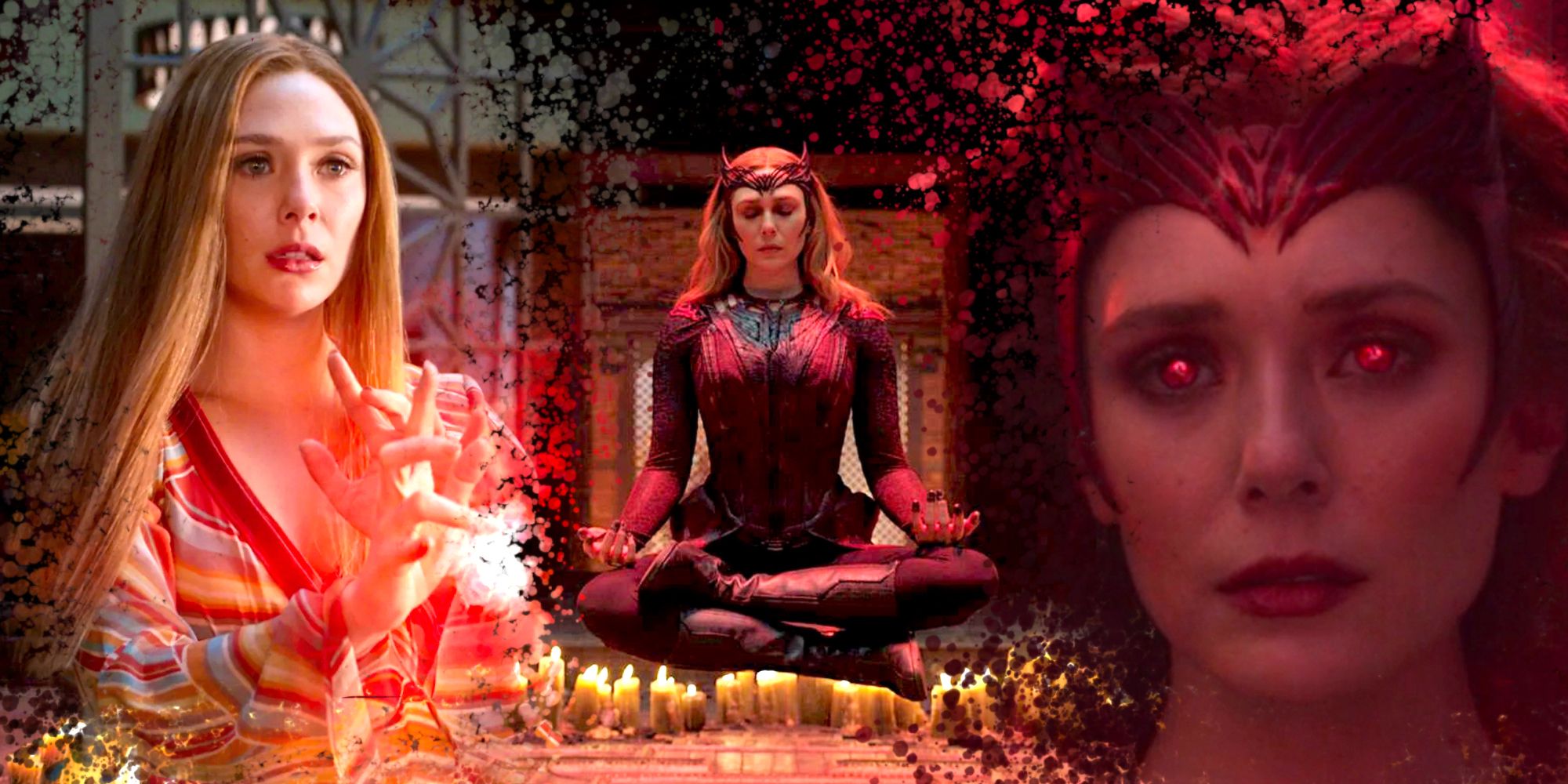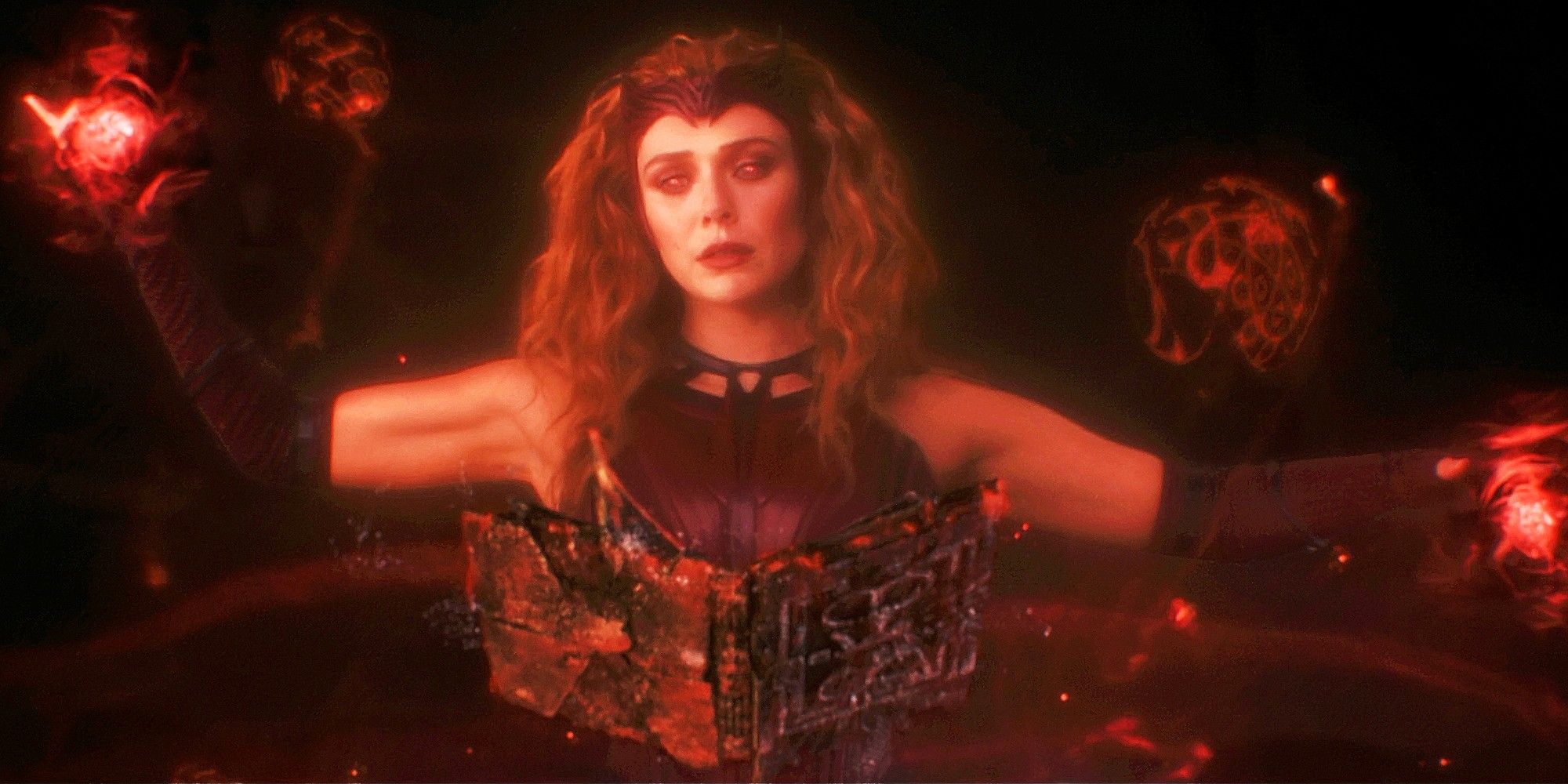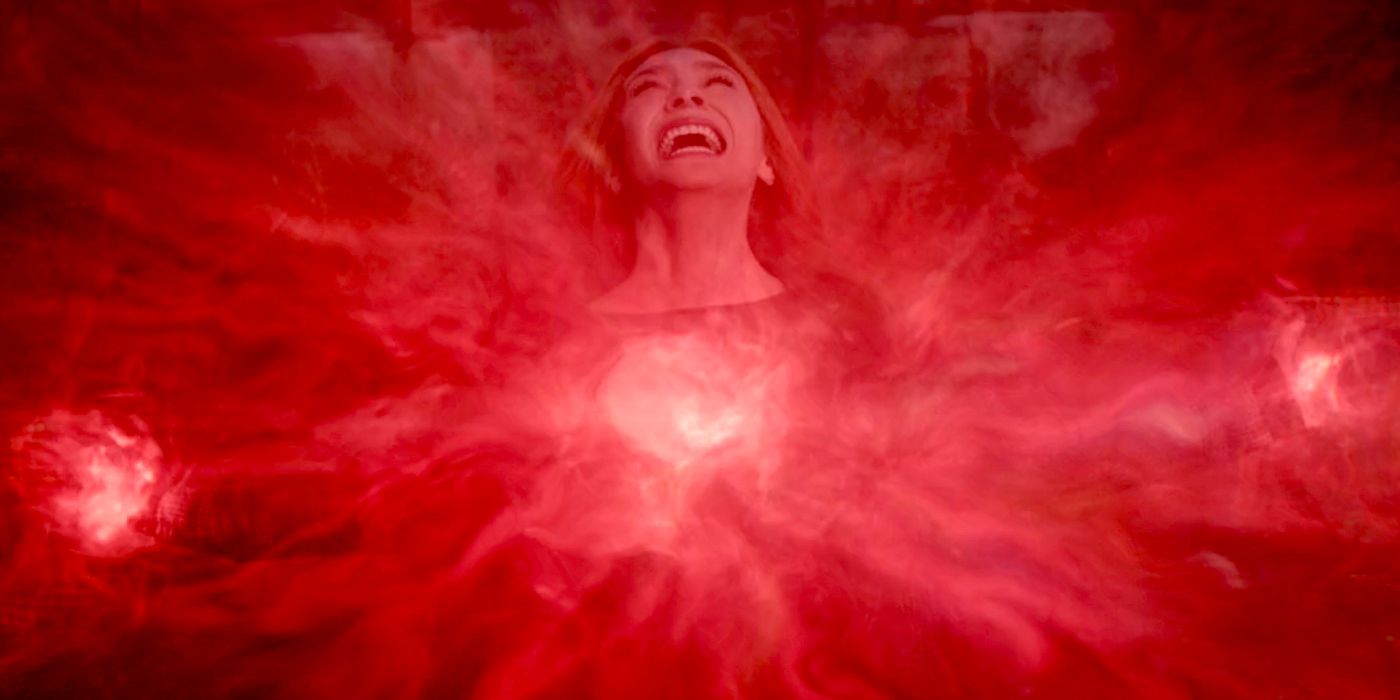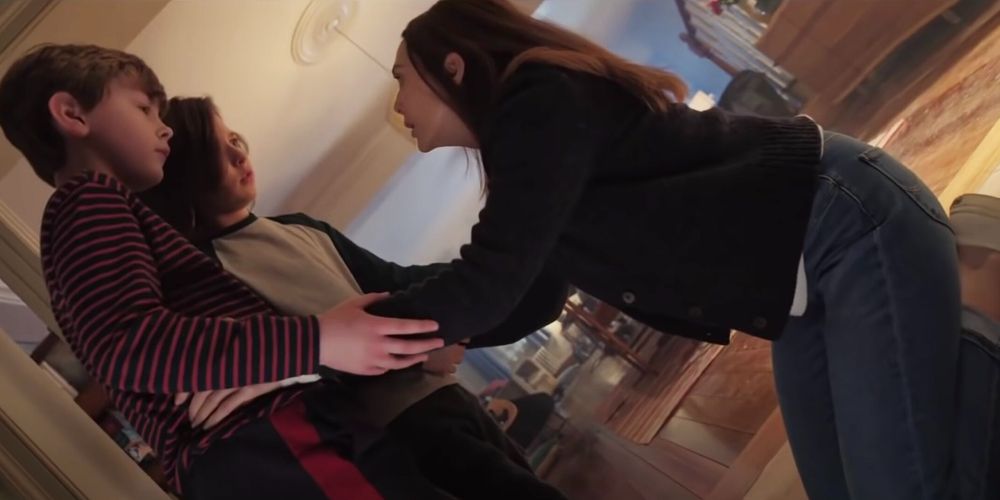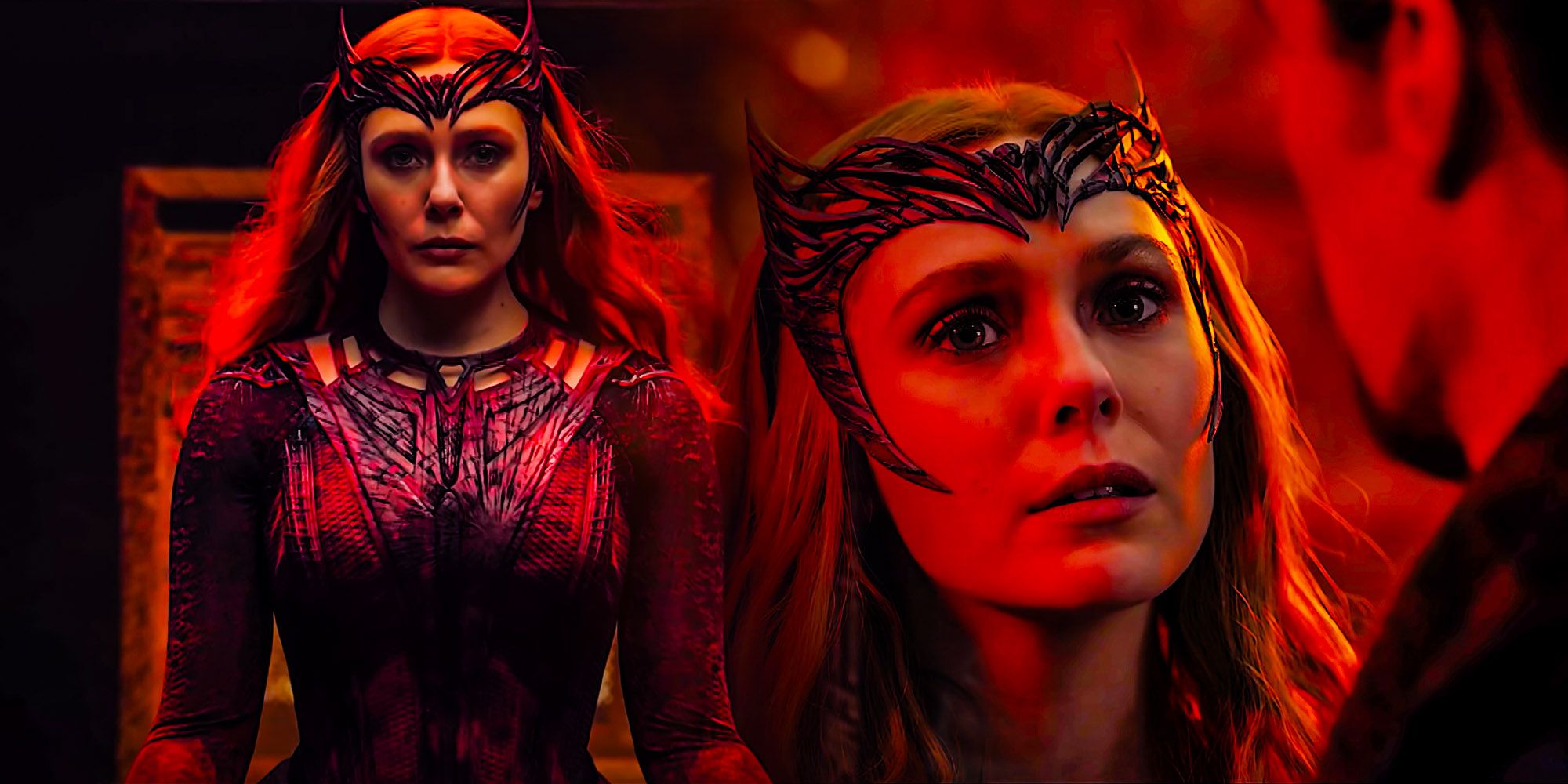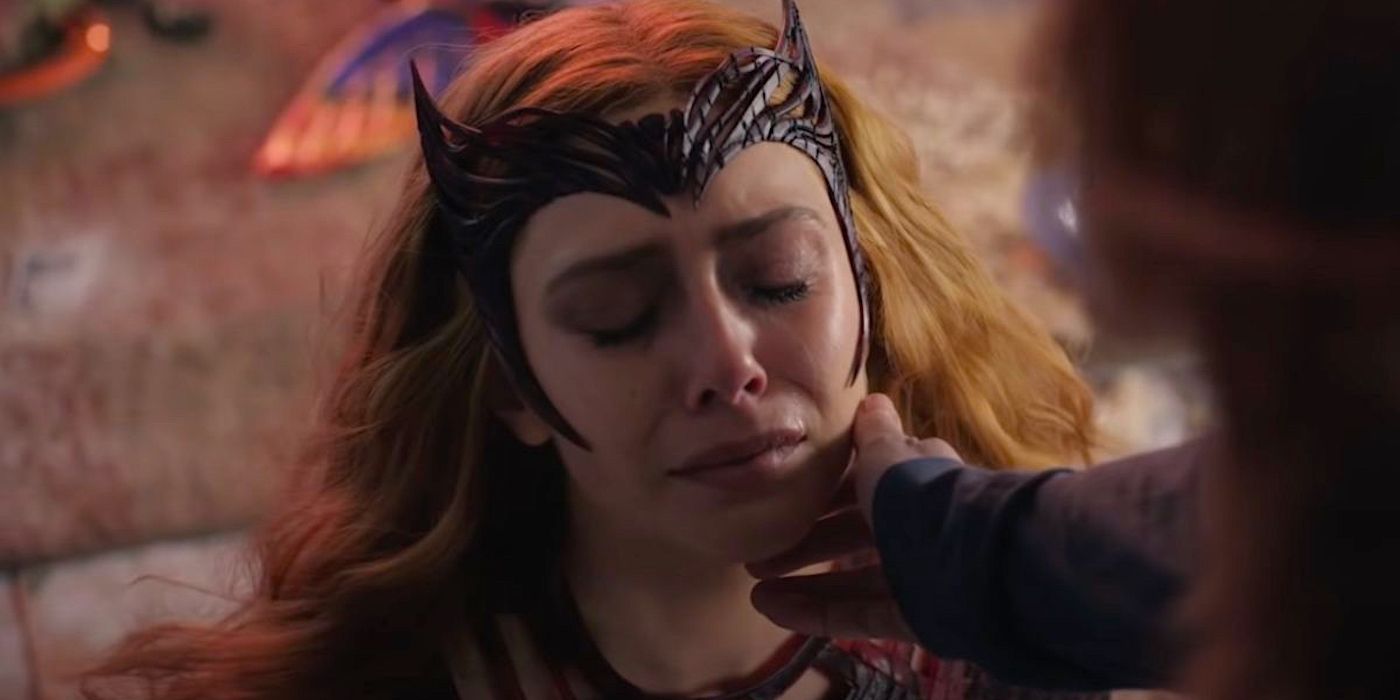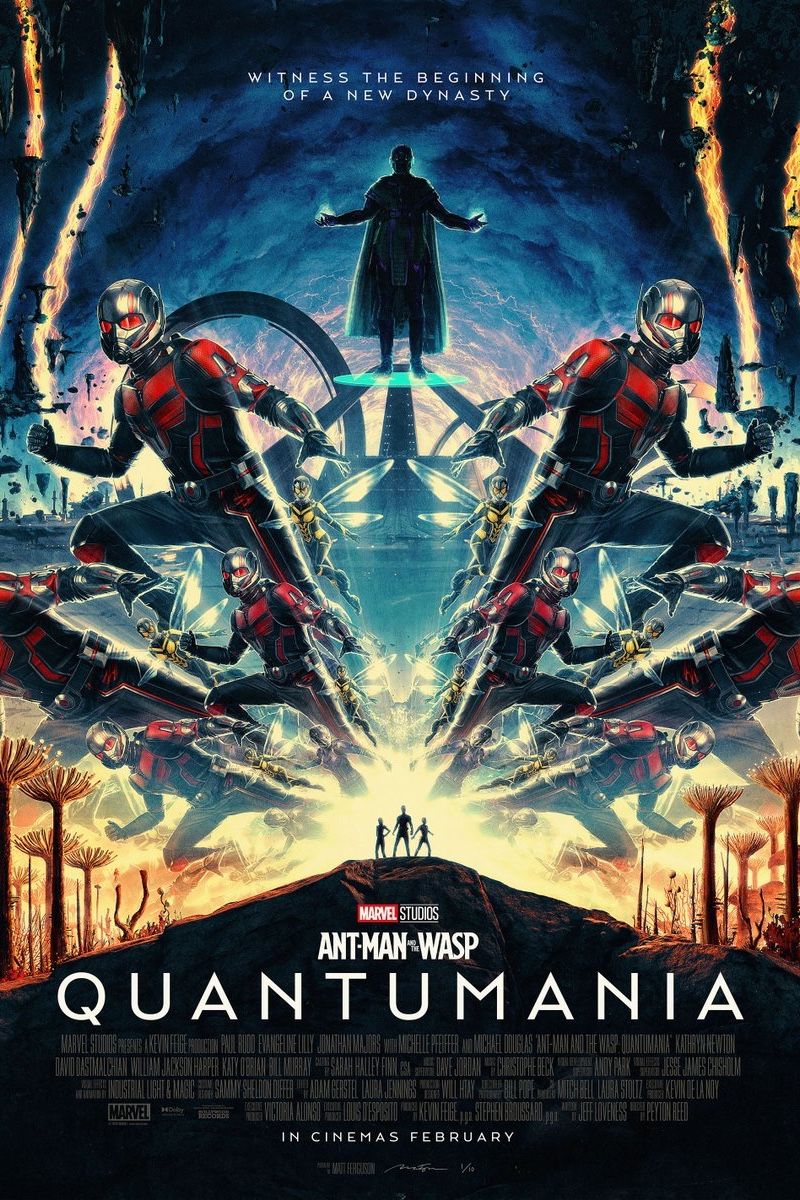Warning: This article contains spoilers for Doctor Strange in the Multiverse of Madness.
Doctor Strange in the Multiverse of Madness not only continues Wanda Maximoff/Scarlet Witch's fascinating arc from WandaVision, but also improves the show's extensive development of the character. Scarlet Witch (Elizabeth Olsen) has walked the line between good and evil, initially appearing in Avengers: Age of Ultron as an antagonist. Wanda has since fought alongside Earth's Mightiest Heroes, though not without enduring a hefty dose of trauma. Armed with Chaos Magic and the Darkhold, the Scarlet Witch assumes a villain's role in Multiverse of Madness, contending with Doctor Strange (Benedict Cumberbatch) and pursuing America Chavez (Xochitl Gomez) with the goal of using her power to escape to an alternate reality in which she can live happily with her children. Doctor Strange in the Multiverse of Madness serves as a logical extension of WandaVision's heart-wrenching story of grief, rendering the Scarlet Witch's collective narrative all the more compelling.
WandaVision landed on Disney+ in early 2021 as Marvel's premiere original series. A stylistic deviant from the superhero genre, WandaVision paid tribute to six different eras of sitcom television across its nine episodes, while illustrating Wanda's turmoil in the fallout of Avengers: Endgame, following Avengers: Infinity War — in which Vision (Paul Bettany) perished at her own hand. Wanda's grief drove her to construct a false reality in the New Jersey town of Westview and create a new Vision in addition to her twin boys Billy (Julian Hilliard) and Tommy (Jett Klyne). Initially unaware of the damage her subjugation inflicted upon the town's residents, Wanda finally released her hold on Westview after Agatha Harkness (Kathryn Hahn) exposed her to the truth of her deed. At WandaVision's conclusion, Wanda recovered the Darkhold from Agatha and fulfilled her destiny as the mythical Scarlet Witch.
A common interpretation of Doctor Strange in the Multiverse of Madness argues that the film erases Wanda’s character development from WandaVision. Contrary to that notion, Doctor Strange 2 sufficiently works in tandem with the Disney+ series, examining the stages of Wanda's grief and fulfilling her sense of identity. Wanda's newfound agency and conviction in Multiverse of Madness represent a satisfying direction for the character, as, in retrospect, WandaVision serves as the beginning of Wanda's self-discovery rather than a singular instance of personal drama. Thanks to its payoff of the Scarlet Witch's arc, Doctor Strange in the Multiverse of Madness not only expands but also enhances WandaVision as a perfect setup for the film.
How WandaVision Prefaced Scarlet Witch’s Role In Multiverse of Madness
WandaVision's finale directly leads into Doctor Strange in the Multiverse of Madness, as Wanda's embodiment of the Scarlet Witch implies her forthcoming villainy. Wanda's recovery of the Darkhold serves as the most prominent sign of her impending turn, as the book contains the dark magic spells needed to augment the Scarlet Witch's abilities and ordain her as the indestructible force she represents in Doctor Strange in the Multiverse of Madness. Agatha explicitly foreshadows Wanda's sinister future, as she remarks to her in episode 8, "You have no idea how dangerous you are," while in WandaVision's finale she declares, “It’s your destiny to destroy the world,” and “You have no idea what you’ve unleashed." Fittingly, the WandaVision finale's post-credit scene depicts Wanda reading the so-called Book of the Damned as Billy and Tommy call for help from another reality. The sequence teases her eventual pursuit of the boys through the multiverse. Even though she let the people of Westview go, Wanda was never redeemed at the ending of WandaVision. It was merely a turning point into the next, darker stage of her grief.
Multiverse Of Madness Is A Continued Exploration Of Wanda’s Grief
In Phase 4, Wanda undergoes two stages of grief. The first, explored in WandaVision, surrounds her coping with the loss of Vision, while Doctor Strange in the Multiverse of Madness tackles Wanda's grief over losing her children. WandaVision saw Wanda express her denial of Vision's death, as she eventually accepts that they must be apart. However, she had only recently created Billy and Tommy, thus leaving her with unprocessed trauma and grief from witnessing her children ripped away from her so soon. A woman losing her lover and a mother losing her children hardly resemble each other, and Marvel does well not to oversimplify Wanda’s grief. The Scarlet Witch's villain arc in Multiverse of Madness represents the stage of anger, as losing her children inflicts a harsher brand of pain. Doctor Strange 2 depicts Wanda's most forceful state of despair stems from an accumulation of grief dating back to losing her parents as a child and watching Pietro die. The Scarlet Witch's desire to escape to an alternate reality reflects the idea of disassociation as a means to cope with trauma.
Multiverse Of Madness Addresses Wanda’s Journey With Motherhood
Doctor Strange in the Multiverse of Madness pays off Wanda's relationship with her children that began in WandaVision. The film examines her journey with motherhood, capitalizing on her desire to reunite with her lost children. Upon discovering Doctor Strange 2's universe of Earth-838, in which Billy and Tommy exist, Wanda employs her abilities to dream-walk into her alternate self. In her pursuit of America, the Scarlet Witch appears unperturbed by her slaughtering of innocents at Kamar-Taj, which at first glance, seems contradictory to the compassion she exhibited at the end of WandaVision.
However, the motivation behind the Scarlet Witch's bloodshed is logical, from a narrative standpoint. To understand her rationale, one must look no further than Agatha Christie's The Last Séance, in which the famous author writes, “A mother's love for her child is like nothing else in the world. It knows no law, no pity. It dares all things and crushes down remorselessly all that stands in its path.” The MCU expertly illustrates these words through Wanda in Multiverse of Madness, as her remarks"This is me being reasonable," and “I’m not a monster . . . I’m a mother” epitomize Wanda's identity as a mother and explain the violent measures to which she resorts in the name of her children. As someone who witnessed her childhood robbed from her by war, Wanda empathizes with neglect and likely feels guilt at the thought of abandoning Billy and Tommy after WandaVision. Her ultimate goal lies in providing her boys with the upbringing that she never had.
Multiverse Of Madness Grants Wanda True Authority (And Accountability)
In WandaVision, Wanda lacked understanding of her power's extent, perpetually distanced from control. In her acceptance of the Scarlet Witch title, Wanda undergoes an immense turning point in her journey, as she chooses to dismantle the Hex, learn from the Darkhold, and use her Chaos Magic to find Billy and Tommy. This event carries an enormous significance because Wanda has lived deprived of agency her whole life. The MCU justifies Wanda's extreme character shift by emphasizing autonomy as its primary factor. The Darkhold may corrupt her already unstable moral code, but it's Wanda who's in control of her actions. Ultimately, intent represents the difference between Wanda's portrayal before the end of WandaVision and the Scarlet Witch in Multiverse of Madness.
In Doctor Strange 2, Scarlet Witch possesses a genuine sense of authority for the first time, as she deliberately leans into the darker version of herself, which she believes is justified by her pursuit of happiness. Wanda is not merely an agent of the Darkhold's chaos, rather she is an autonomous woman who decides it is worth being perceived as a monster to recover what she has lost. When she finally reverses course at the sight of her frightened children, she destroys the Darkhold entirely on her own terms — symbolizing her ultimate acceptance of accountability that was absent from WandaVision. The essence of Scarlet Witch's MCU arc is defined by her pursuit of control pertaining to her own life. It would have been reductive if the Scarlet Witch's Multiverse of Madness ending had involved Strange or another character defeating her, as her choice of accountability demonstrates her growth as a self-governed woman, and there is nothing more powerful than that.
How Multiverse Of Madness Sets Up Wanda’s Redemption
Despite bringing down Mount Wundagore's tomb on herself at the end of Doctor Strange 2, there's little reason to believe that the all-powerful Scarlet Witch is truly dead in the MCU. The ambiguous nature of her ending suggests that Wanda could reappear in the MCU. The circumstances of her return remain a mystery, but Multiverse of Madness presents the opportunity for Wanda to redeem herself and embody the final stage of her grief — acceptance. It's possible that Wanda will seek out Agatha, who, as of WandaVision's finale, still resides in Westview. The MCU could foreshadow a future project involving the two witches in the upcoming Disney+ series Agatha: House of Harkness. Now that Wanda and Agatha have ditched the Darkhold, an opportunity exists for them to mirror their comic-book relationship of a mentor-mentee dynamic. Most importantly, though, the Scarlet Witch's redemption must feel earned, as grief and trauma cannot disappear in an instant. Healing from a spell of misguided actions promises to make for a captivating segment of Wanda's, thus, the MCU is poised to deliver a monumental piece of storytelling following Doctor Strange in the Multiverse of Madness.

